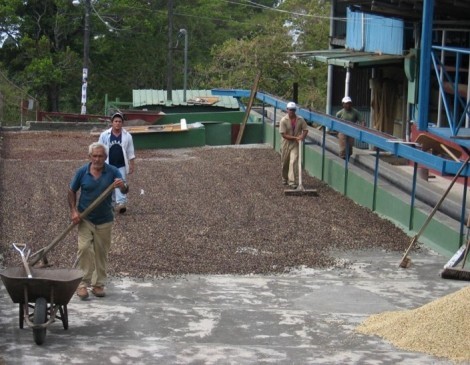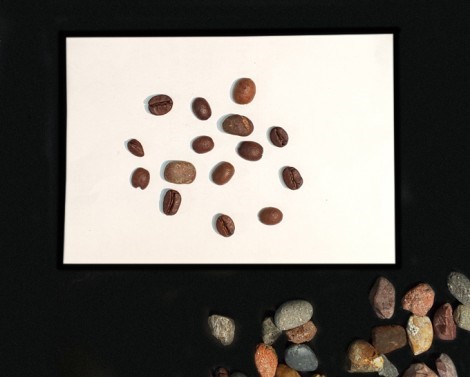From Farm to Fork: Vision systems in the food industry
From Farm to Fork: Vision systems in the food industry

While language and culture distinguish nations all over the world, there is nothing that brings all people together like good, wholesome food. The steady supply of safe food may be taken for granted; however, professionals in agriculture and food packaging industries know exactly how important it is to analyze, monitor and inspect food products in the packaging process. These companies face significant challenges like agricultural products contaminated with stones or other debris, broken or unsealed packages, mislabeled products, and spoiled produce. Fortunately, many solutions are available using today’s technologies including SWIR, InGaAs, CCD/CMOS and X-ray.
One example is seen in coffee production, which is enhanced through machine vision. To dry coffee beans, they are placed on a tarp on the ground, raked up and put in a hopper.

During this raking process, rocks or gravel can easily get mixed in with the coffee beans. These stones need to be sorted out before the beans are packaged. If stones go unnoticed and are packaged with the coffee beans, they can present sanitary issues and can cause coffee grinders to break. Machine vision can be used to distinguish between items of similar shape and size.

Placing cameras and detectors in strategic locations throughout the line will help identify materials based on their SWIR spectra, enabling distinction between coffee beans and stones.
As an example, coffee bean vendors complete the drying process and then pack up the beans to be sent to coffee companies. They use integrated vision-assisted systems to separate the good beans and the bad ones, including identifying foreign objects such as stones.
Protecting and preserving foods and packaging
Fortunately, cameras, and sensors are available for use in devices designed for improving food inspection, sorting, safety and quality. These systems can give inspectors the capability required to identify issues in food products and packaging before they are shipped out. Vision inspection can prevent unsafe, low-quality food from reaching shelves and saving businesses costs on returned defective packages. Whether processes require straightforward short-wave infrared (SWIR) detection or customized solutions, we identify here many solutions that can enhance agricultural product and packaging safety.
Industrial problems
With world population currently at 7.7 billion and expected to grow to 9.7 billion by 2025, agricultural companies are challenged to keep up with the increasing demand for high quality food. To be successful, they must continually analyze and optimize the food sorting and inspection process.
Historically, humans were used to manually sort food along the conveyor belt, ensuring that only high-quality produce reached the stores. As produce volume continues to grow, this becomes no longer feasible due to accuracy and cost issues such as:
● Human vision can get confused by similar colors and shapes, and also cannot identify defects under skin or packaging
● Increased volume of produce traveling down the conveyor belt
● High labor costs
● Costs to return defective products after reaching the market
These issues helped pave the way for automated machine vision technology. With machine vision, businesses can reduce errors in food sorting and packaging by detecting issues a human being would find difficult, if not impossible, to see. Examples of some of these issues include: moisture content and bruising on or beneath the skin of fruit and vegetables, leaking packaging, and distinguishing between foreign objects and goods of similar shapes and colors.
SWIR: See beneath the surface
Moisture content can greatly affect the quality and shelf life of agricultural products. The slight trace of additional moisture can indicate the start of mold. A bruise indicates that oxygen has penetrated the skin or peel and gotten into the fruit. Bruised fruit or vegetables will have brown spots and/or eventually turn completely brown. While most are safe to eat, bruised fruit is not aesthetically appealing or can be over-ripe.
To optimize the food sorting inspection process, it is necessary to place different high-speed imaging devices at strategic locations on the conveyor belt. These sensors will automatically scan produce, detecting visible and invisible defects on produce that should be filtered out, so they do not reach the store.
As apples travel down the conveyor belt, they are scanned using InGaAs and CMOS cameras. The InGaAs camera will show defects beginning to form under the skin that a human eye cannot see. The CMOS camera will show visible defects.
InGaAs sensors
There are two different types of InGaAs image sensors: linear and area. InGaAs linear image sensors are suitable for in-line sorting of agricultural products because of their high-speed line rate and high sensitivity. They are available in a variety of cutoff wavelengths, pixel counts and line readout speeds. Most of these linear image sensors have a metal or ceramic package, but there are others with a flexible plastic cable as a less expensive option. InGaAs area image sensors are suitable for hyperspectral imaging. High-speed frame rate, low readout noise and high sensitivity characterize these area arrays. They are available in various cutoff wavelengths, pixel arrays and frame rates.
InGaAs cameras provide plug-and-play solutions using 1D or 2D InGaAs image sensors. They are also an easy solution for multispectral/ hyperspectral imaging (HSI)cameras to be built based on the original camera.
Packaging defects
Once the food is packaged, defects that were not previously spotted can be found using a CCD/CMOS industrial camera. As large volumes of consumer packaged goods travel down the process line, CCD/CMOS cameras can identify visible defects, such as dents or punctures in packaging. High-speed and high-resolution requirements should be prioritized. Sometimes leaks occur underneath the packaging of a product, which InGaAs cameras can detect. When leakage occurs, these defective products need to be sorted out and not go to market. Sometimes containers traveling through the process line are not filled to proper standards, and InGaAs cameras can detect improperly filled containers, too.
Silicon-based image sensors for UV-VIS
For UV-VIS imaging used in food inspection, Hamamatsu offers a selection of complementary metal oxide semiconductor (CMOS) image sensors in linear and area arrays. Innovations in CMOS technology have made these image sensors easy to use because all essential signal processing circuits are formed on the sensor chip, and only simple input pulses and a single power supply are needed to operate them. High-speed CMOS image sensors in machine vision imaging systems are used in food production for packaging, such as inspecting labels, checking for dented merchandise or other visible defects.
CMOS products:
● CMOS linear image sensors have high sensitivity from UV to the near-infrared region up to 1100 nm. They are available in a variety of pixel configurations (from 128 pixels to 4,096 pixels), sensitivity, and line speeds
● CMOS area image sensors are available in various array configurations, ranging from 30 x 30 pixels to 1,280 x 1,024 pixels
InGaAs detectors and cameras for SWIR imaging
InGaAs linear image sensors are suitable for in-line sorting of agricultural products because of their high-speed line rate and high sensitivity. They are available in a variety of cutoff wavelengths, pixel counts and line readout speeds. Most of these linear image sensors have a metal or ceramic package, but others come with a flexible plastic cable as a less expensive option.
SWIR hyperspectral imaging is just beginning to be used in food processing applications such as almond grading and quality inspection, capable not only of detecting foreign objects but also of grading food such as nuts or identifying ingredients.
In other applications such as monitoring crops, produce, identifying fruit sweetness, etc., one hyperspectral solution is an image sensor module, with a wide range of wavelength options (e.g., up to 2.55 µm),which could be used in hyperspectral imaging systems in combination with dedicated optics.
InGaAs area image sensors are suitable for SWIR hyperspectral imaging. Food inspection typically requires high-speed frame rate, low read-out noise, and high sensitivity characterize these area arrays. Hamamatsu Photonics provides a complete product line with various cutoff wavelengths from 1.7um to 2.5um, also providing options from sensors to modules.
Article Source: https://www.novuslight.com/from-farm-to-fork-vision-systems-in-the-food-industry_N11583.html#atop